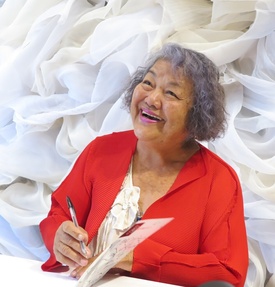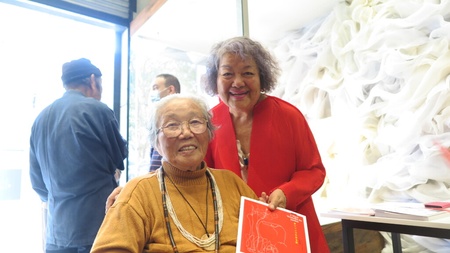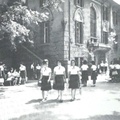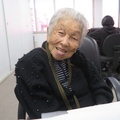Alianza, where 1,000 Japanese families flocked during the Taisho Democracy period
"When my father saw the primeval forest, he was so overwhelmed with emotion that he knelt before the earth, thinking that he was going to create a new culture here. I felt that there was something in common with what Suzuki Shoko said."
Katsue Yuba (75 years old, second generation), the youngest daughter of Isamu Yuba, founder of Yuba Farm in Aliança, made this comment, which had a sense of history, on the 5th at a publication commemorative event called "Remembering 50 Years of Katsushige Yuba" at the store of famous designer Fernanda Yamamoto in the Vila Madalena district of São Paulo.
Yuba Farm is an agricultural community that was established by Yuba Isamu and his friends in 1935 in Alianca 1, about 600 km northwest of São Paulo. It continues to practice "prayer, cultivation, and art," and even now, 88 years after its founding, about 60 people from the first to fifth generations live there.
Katsushige was born in October 1947 as Isamu's youngest daughter. The farm faced many difficulties and even went bankrupt at one point. However, the members helped each other out and continued to pursue their dream of "creating new culture," working on farming during the day and artistic activities at night and on weekends. The annual Christmas performances held at the Yuba Theater on the farm attract many fans from the city of São Paulo and the surrounding area.
Katsushige said, "Next year, First Alianza will celebrate its 100th anniversary. Six generations have been born in Alianza, and they live with pride as descendants of Japanese immigrants. I wanted to publish this book, although it is a small thing, as a sort of pre-celebration. Our fathers built Alianza, created Yuba Farm, and raised us. The first settlers a century ago started from nothing. I want to convey my gratitude to those pioneers. This means a lot to me. I hope that by reading this book, people will understand that the great love of the First Generation who raised us continues to this day, even after 100 years."
In November 1924, when the advance party settled in Alianza I, Japan was in the midst of the Taisho democracy. Intellectuals influenced by that era came to South America in large numbers, seeking cultural creation in a completely new land. The Yuba family was among the main party that arrived from Japan the following year in 1925. Alianza II was built in 1926, and Alianza III in 1927, meaning that in just three years, an astonishing 1,000 Japanese families had come to the virgin forests of South America.
Yuba Farm was born as "God's plan"
The settlers were people who had the financial means to buy farmland in Japan. So they brought along encyclopedias, collections of world literature, pianos, and telescopes, and came to the primeval forest with the intention of leading a cultured life. To many of the previous immigrants who had gone there without food or food, they looked like they had come to the frontier with the same atmosphere as if they were just hanging around Ginza, so they were mocked as "Ginbura immigrants."
Yuba Isamu, 19 years old when he went to Brazil, was a devout Christian and a literary boy at the same time. His outlook on life was shaped by the works and ideas of Mushanokoji Saneatsu. He was particularly fascinated by Mushanokoji's essays on Tolstoy, and read all of Tolstoy's works. Inspired by Tolstoy's humanism, Mushanokoji gathered together the Shirakaba school of writers and founded the "New Village" in 1918 (Taisho 7), but it was unsuccessful. It is said that Yuba took inspiration from a cooperative farm run by immigrants from Latvia, a small Nordic country located near Aliança, and aimed to create a Brazilian version of it.
On the day of the event, a never-ending line of people gathered at the special venue set up at the entrance to the store, asking for his autograph, and Katsue spoke to each person as he slowly wrote with his pen. "My father always said, 'I didn't build Yuba Farm. It was God's plan. So you guys should become people who can talk to God. Birth and death are both part of God's plan. So I didn't write this book because I wanted to. I can't talk to God, but I just wrote down the things that came into my head," he said, sounding almost like an automatic writer.
Katsushige has published writings and books about the memories of the people who have created the history of the farm and the things that have inspired him in his life. This time, he will celebrate the publication of his four most recent books: "Stories of the Mountain" (2021, first published in 1993), "The Glorious Pioneer" (2020), "A Garden with Red Apples" (2023), and "A Piano with Socks" (2023) .1
Akiko prays to "Ave Maria"
Among them, "A Garden with Red Apples" is a new work inspired by the ceramic artist Akiko Suzuki. When Katsushige stayed at Akiko's house for about two weeks, he listened to her interesting stories every night. This left a strong impression on him, and led to the creation of this book.
Akiko (94 years old, from Tokyo) has been wheelchair-bound since suffering a cerebral hemorrhage, has given up her creative activities, sold her home and now lives in a nursing home, but she appeared at the venue on the day accompanied by her daughter.
When Katsushige saw Akiko appear in a wheelchair, he immediately ran over to her. Holding Akiko's hand tightly, Katsushige declared, "I'll sing!" and began to sing Schubert's opera "Ave Maria" at a rousing pace. As if responding to the rising voice of the song, Akiko shook her hand back, occasionally clasping her hands together as if in prayer. It was a scene that evoked a sense of reverence, and the Brazilians around her also had solemn expressions on their faces.
Regarding the publication of a book about her, Akiko said, "I have never been so happy. I am so happy to feel the love from the world. I feel that Katsushige's spirituality is something I can share with her. Katsushige is a person with dreams, a romantic. That's why I love the Ave Maria she sings."
In 1961, when Akiko was studying pottery under the disciples of Itaya Hazan (1872-1963), a pioneer of modern Japanese pottery, she saw Oscar Niemeyer's design drawings on an NHK program featuring plans to relocate the capital to Brasilia. She had the hunch that "I was shocked. It was simply incredible. I should go to Brazil." The next day, she put her house up for sale and moved to Brazil in 1963.
"Ever since I was little I had a vague idea that I wanted to go to a wide open place. Somewhere where I could see the horizon would be nice. So when I saw that program I knew this was it. They also introduced Japanese immigrants. It wasn't just that I wanted to go, I had a strong feeling that I had to go. I talked it through with my husband, who was an artist, and we made the decision right away," she recalls.
Note 1: If you are interested in the book, please contact Yuba Farm (tel. 18-3708-1247/1290, A/C Associacao Comunidade Yuba, CP 531, 1ª Alianca, CEP 16800-000 – Mirandopolis – Sao Paulo – BRASIL).
*This article is reprinted from the Brazil Nippo (August 22, 2023).
© 2023 Masayuki Fukasawa







